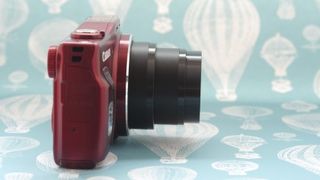Why you can trust TechRadar
Generally speaking, Canon compact cameras are excellent performers and always come high on our list of recommendations. Sitting at the top of the travel range and featuring advanced specifications such as the Digic 6 processor, I had pretty high hopes for the SX700HS.
Fortunately I have not been disappointed by what the camera is capable of producing. Colours are bright and punchy, demonstrating a pleasing level of warmth that is pretty typical of Canon cameras, both from their compact and DSLR range.

Detail is resolved very well, especially for a camera with a sensor of this size. There's not too much evidence of image smoothing at the lower end of the sensitivity scale – even when zooming in at 100%. As you creep up the sensitivity scale, as we'd expect, there is some loss of detail, but generally when looking at images at normal printing or web sharing sizes, the overall impression of detail is very pleasing.
This brings us around to the topic of noise. With the addition of a Digic 6 processor, the camera should be very capable in low light shooting scenarios. At mid-range sensitivities of around ISO 800, noise is very, very minimal. Although there is some smoothing of detail, it's generally very good, and this is likely to be a very commonly used sensitivity for a lot of occasions.
Even at high sensitivities, such as ISO 1600, examining the image at 100% reveals very little noise, but a touch more image smoothing. As the camera doesn't shoot in raw format, you won't be able to control the amount of noise reduction which is applied if you prefer detail resolution – but I don't think that you'll be disappointed in the majority of shooting conditions.
Generally speaking, the camera's metering does a very good job of helping to produce balanced exposures. I found that I very rarely had to dial in any positive exposure compensation due to underexposure, something which a lot of compact cameras tend to suffer with.

Similarly, the camera's automatic white balance setting does an excellent job of producing accurate colours, even while shooting under artificial lighting conditions.
Most of the time, focusing is swift and accurate. In very bright conditions, it's very quick indeed, dropping a little in lower light conditions as is to be expected, but it's certainly competitive with other cameras of its kind. Macro focusing is also pretty impressive, allowing you to get extremely close to the subject – great for those who want to shoot frame filling views of flowers and the like.

As the zoom is the key selling point of the SX700, it's pretty much vital that it does a good job. At the telephoto end of the optic, there's a very noticeable difference between using the camera's image stabilisation and switching it off. With it switched on, you're able to accurately frame and compose an image, while the resulting shot stays blur free. There's lots of detail retained at that far point too. If you need extra reach, ZoomPlus technology does a decent job too, and while it's not as high quality as the optical zoom, if you're sharing online at normal sizes, the overall impression is great.

Lots of compact cameras include creative modes as manufacturers are keen to appeal to the Instagram crowd. Here on the SX700HS, the most interesting filters can be found in the Creative Shot mode, with lots of fun and wacky filters applied randomly to your images. It's worth experimenting with these, but as mentioned before, it's a shame you can't have more control over these filters.
On the plus side, when shooting in Creative Shot, you also get a standard version of the image, should you need it. The same can't be said for when shooting in the general Creative Mode, or if you're using a film simulation setting, where you'll be stuck with whatever filter you apply to a JPEG image.
Amy has been writing about cameras, photography and associated tech since 2009. Amy was once part of the photography testing team for Future Publishing working across TechRadar, Digital Camera, PhotoPlus, N Photo and Photography Week. For her photography, she has won awards and has been exhibited. She often partakes in unusual projects - including one intense year where she used a different camera every single day. Amy is currently the Features Editor at Amateur Photographer magazine, and in her increasingly little spare time works across a number of high-profile publications including Wired, Stuff, Digital Camera World, Expert Reviews, and just a little off-tangent, PetsRadar.


